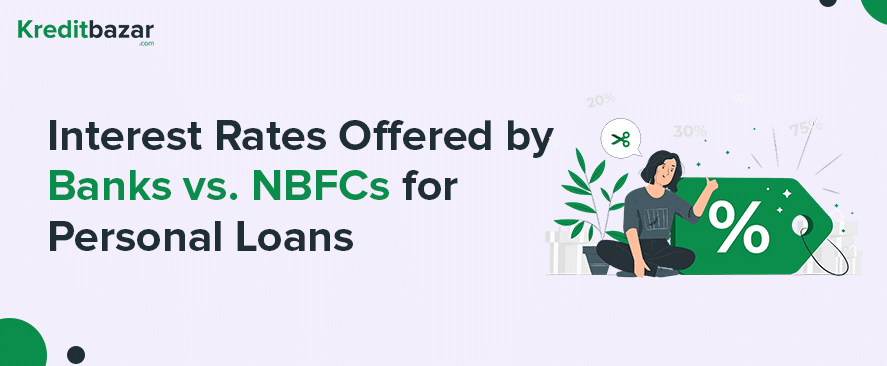![]()
Table of Contents
When choosing a personal loan, understanding the difference between the interest rates offered by banks and Non-Banking Financial Companies (NBFCs) is crucial. At Kreditbazaar, we partner with both banks and NBFCs to provide pre-approved personal loans tailored to your financial needs. Whether you prioritize lower interest rates, quicker approvals, or flexible eligibility, comparing bank and NBFC personal loans can help you make an informed decision.
Bank Personal Loan Interest Rates
Banks in India are known for offering competitive interest rates on personal loans. These rates are typically lower than those offered by NBFCs, making banks a popular choice for borrowers with a good credit score and stable income.
Typical Interest Rates Offered by Banks
- State Bank of India (SBI): Interest rates generally range from 10% to 13% for personal loans.
- HDFC Bank: Offers personal loans with interest rates starting from 10.50% to 16%, depending on the borrower’s credit profile.
- ICICI Bank: Provides personal loans at interest rates between 11% and 17%, with flexible repayment options.
These interest rates vary based on factors such as the borrower’s credit score, income stability, loan amount, and tenure.
Features of Bank Personal Loans
- Eligibility Criteria: Banks typically require a good credit score (above 750), stable employment, and a regular income. Salaried professionals often receive better terms compared to self-employed individuals.
- Processing Fees: Banks usually charge a processing fee between 1% and 2.5% of the loan amount.
- Repayment Tenure: Most banks offer flexible repayment tenures, ranging from 1 to 5 years, making it easier for borrowers to choose a tenure that fits their financial plans.
Why Banks Offer Lower Interest Rates
- Regulated Lending Practices: Banks are more heavily regulated by the Reserve Bank of India (RBI) compared to NBFCs, ensuring transparency and fairness in lending.
- Credit Score Focus: Banks tend to offer lower interest rates to borrowers with higher credit scores and strong financial backgrounds, as they pose a lower risk to the lender.
- Risk Management: Because banks carefully assess the borrower’s repayment ability, they are more likely to offer lower rates to mitigate potential defaults.
For borrowers who meet the eligibility criteria, banks are a cost-effective option for personal loans, especially for those looking for lower EMIs and reduced interest payments over time.
People Also Read: How Interest Rates Are Calculated?
NBFC Personal Loan Interest Rates
NBFCs offer more flexible lending options, catering to individuals who may not meet the strict eligibility criteria of banks. However, this flexibility often comes at the cost of higher interest rates.
Interest Rates Offered by NBFCs
- Bajaj Finserv: Typically offers personal loans with interest rates ranging from 12% to 24%, depending on the borrower’s creditworthiness and financial profile.
- Tata Capital: Provides personal loans with interest rates starting from 10.99%, but they may go up to 20% for high-risk borrowers.
- Muthoot Finance: Known for offering personal loans at higher interest rates, usually starting from 13% and going up to 26%, depending on the risk factors.
Features of NBFC Personal Loans
- Flexible Eligibility Criteria: NBFCs tend to have more lenient eligibility requirements, making personal loans accessible to individuals with lower credit scores or inconsistent income sources.
- Quicker Processing Times: NBFCs are known for their faster loan approval and disbursal process, sometimes within 24 to 48 hours.
- Higher Interest Rates: Due to the increased risk associated with more flexible eligibility criteria, NBFCs generally charge higher interest rates compared to banks.
Why NBFCs Charge Higher Interest Rates
- More Lenient Lending Criteria: NBFCs are willing to lend to individuals with low credit scores or less stable income, but they offset this higher risk by charging a higher interest rate.
- Higher Risk of Default: Since NBFCs cater to riskier borrowers, they compensate for potential defaults by increasing the interest rate.
- Less Regulation: NBFCs are subject to fewer regulatory constraints than banks, giving them more freedom to set higher interest rates based on borrower risk.
While NBFCs may charge higher rates, they provide a vital service to borrowers who may not qualify for traditional bank loans due to lower credit scores or non-standard employment.
People Also Read: Hidden Charges on Personal Loans
Comparison Between Banks and NBFCs
When comparing personal loans from banks and NBFCs, it’s important to consider several factors, including interest rates, loan processing times, and borrower requirements.
Key Differences in Interest Rates, Loan Processing, and Borrower Requirements
| Criteria | Banks | NBFCs |
| Interest Rates | Generally lower, ranging from 10% to 17% | Higher, typically ranging from 12% to 24% |
| Eligibility Requirements | Stricter, focused on high credit scores | More flexible, and lenient for low credit scores |
| Processing Time | Slower, can take 3-7 days | Faster, often within 24-48 hours |
| Loan Tenure | Offers longer tenures, up to 5 years | Offers shorter or medium-term tenures |
| Risk Management | Lower-risk borrowers, better terms | Higher-risk borrowers, higher interest rates |
Advantages of NBFCs:
- Faster Approval: NBFCs are ideal for borrowers who need quick access to funds, as their approval process is faster than that of banks.
- Flexible Eligibility: Individuals with low credit scores or irregular income streams can still qualify for personal loans from NBFCs.
Disadvantages of NBFCs:
- Higher Interest Rates: The biggest drawback of opting for NBFCs is the higher interest rate, which increases the overall cost of the loan.
- Shorter Tenures: NBFCs may offer shorter tenures, which can result in higher monthly EMIs.
On the other hand, banks provide more competitive rates and longer repayment tenures, making them suitable for individuals with strong financial profiles who prioritize low-interest EMIs over fast processing.
Example: Impact of Choosing a Bank vs. NBFC
Let’s consider a borrower who needs a loan of ₹5 lakh for 5 years. If the borrower qualifies for a bank loan with a 12% interest rate, their monthly EMI would be approximately ₹11,122. However, if the same borrower opts for an NBFC loan at an 18% interest rate, the EMI would rise to around ₹12,713. Over the loan tenure, the borrower would pay ₹95,000 more in interest if they choose the NBFC over the bank.
This example highlights how choosing between a bank and an NBFC can significantly impact the total interest paid and the monthly EMI. Borrowers need to weigh the trade-off between quicker access to funds (NBFCs) and lower overall loan costs (banks).
People Also Read: What are Interest Rates in September 2024
Conclusion
Both banks and NBFCs offer valuable personal loan options, but the choice between them depends on your financial profile and loan requirements. While banks generally provide lower interest rates and longer tenures, NBFCs cater to borrowers who prioritize speed and flexibility, albeit at higher interest costs. At Kreditbazaar, we work with both banks and NBFCs to offer you the best possible personal loan options based on your needs. Use our loan comparison tools to explore the interest rates and features of various lenders to find the loan that best fits your financial situation.



